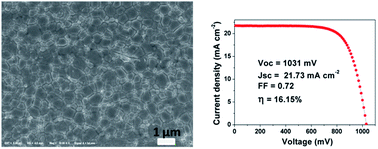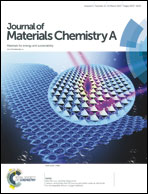Improved air stability of perovskite hybrid solar cells via blending poly(dimethylsiloxane)–urea copolymers†
Abstract
A new kind of PDMS–urea co-polymer has been synthesized and successfully incorporated into the fabrication process of perovskite solar cells. Such a polymer possesses both a flexible and hydrophobic PDMS backbone and urea groups capable of hydrogen binding. Scanning electron microscopy showed that the morphology of the perovskite layer was greatly improved after addition of 10 mg ml−1 PDMS–urea into perovskite precursor solution. As a result, the short circuit current of the devices was improved by 10% and the energy conversion efficiency by 27%, reaching 16.15% under 1 sun simulated sunlight. Steady-state photoluminescence spectra reveal a much improved photoluminescence intensity after the introduction of PDMS–urea into the perovskite layer. The devices with the perovskite-PDMS–urea (20 mg ml−1) hybrid demonstrate an almost unchanged efficiency for 2500 h, proving its remarkable effect on improving the stability of perovskite solar cells.



 Please wait while we load your content...
Please wait while we load your content...